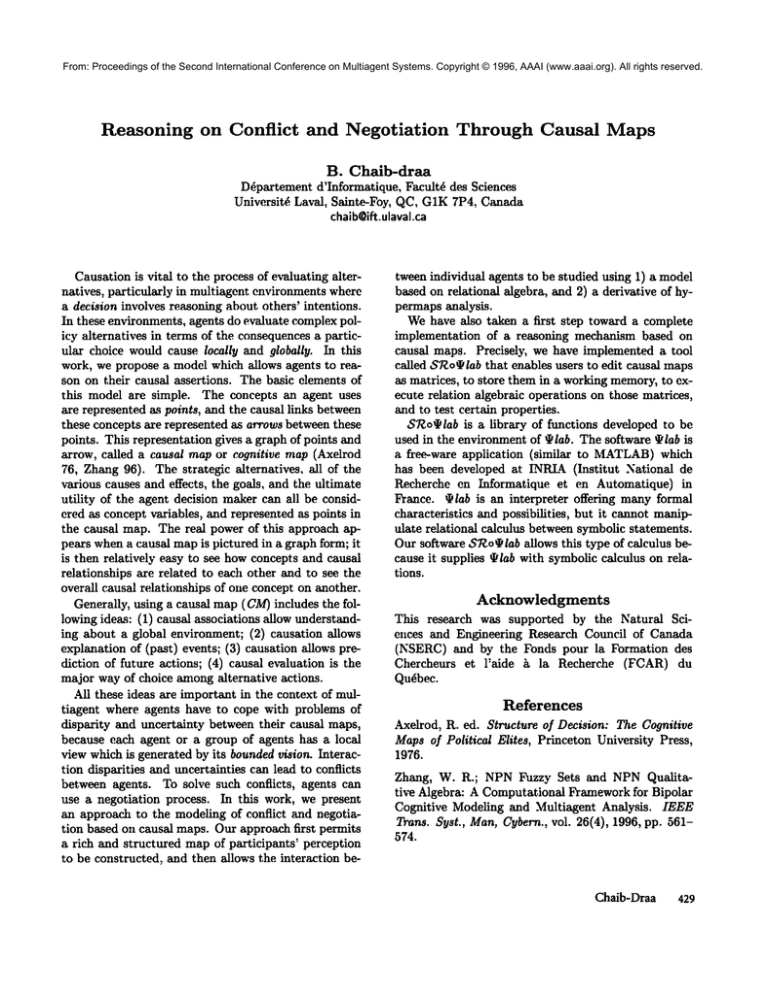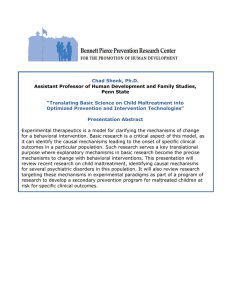
From: Proceedings of the Second International Conference on Multiagent Systems. Copyright © 1996, AAAI (www.aaai.org). All rights reserved.
Reasoning
on Conflict
and Negotiation
Through Causal
Maps
B. Chaib-draa
D~partement d’Informatique, Facult~ des Sciences
Universit~ Laval, Sainte-Foy, QC, GIK 7P4, Canada
chaib@ift.ulaval.ca
Causation is vital to the process of evaluating alternatives, particularly in multiagent, environments where
a decision involves reasoning about others’ intentions.
In these environments, agents do evaluate complex policy alternatives in terms of the consequences a particular choice would cause locally and globally. In this
work, we propose a model which allows agents to reason on their causal assertions. The basic elements of
this model are simple. The concepts an agent uses
are represented as points, and the causal links between
these concepts are represented as arrows between these
points. This representation gives a graph of points and
arrow, called a causal map or cognitive map (Axelrod
76, Zhang 96). The strategic alternatives, all of the
various causes and effects, the goals, and the ultimate
utility of the agent decision maker can all be considered as concept variables, and represented as points in
the causal map. The real power of this approach appears when a causal mapis pictured in a graph form; it
is then relatively easy to see howconcepts and causal
relationships are related to each other and to see. the
overall causal relationships of one concept on another.
Generally, using a causal map(CA/) includes the following ideas: (1) causal associations allow understanding about a global environment; (2) causation allows
explanation of (past) events; (3) causation allows
diction of future actions; (4) causal e~aluation is the
major way of choice anlong alternative actions.
All these ideas are important in the context of multiagent where agents have to cope with problems of
disparity and uncertainty between their causal maps,
because each agent or a group of agents has a local
view which is generated by its bounded vision. Interaction disparities and uncertainties can lead to conflicts
between agents. To solve such conflicts, agents can
use a negotiation process. In this work, we present
an approach to the modeling of conflict and negotiation based on causal maps. Our approach first permits
a rich and structured map of participants’ perception
to be constructed, and then allows the interaction be-
tween individual agents to be studied using 1) a model
based on relational algebra, and 2) a derivative of hypermaps analysis.
Wehave also taken a first step toward a complete
implementation of a reasoning mechanism based on
causal maps. Precisely, we have implemented a tool
called ST~o@labthat enables users to edit causal maps
as matrices, to store them in a working memory,to execute relation algebraic operations on those matrices,
and to test certain properties.
ST~ogllab is a library of functions developed to be
used in the environment of ellab. The software @labis
a free-ware application (similar to MATLAB)
which
has been developed at INRIA (Institut
National de
Recherche en Informatique et en Automatique) in
France. @lab is an interpreter offering many formal
characteristics and possibilities, but it cannot manipulate relational calculus between symbolic statements.
Our software 3T~o@laballows this type of calculus because it supplies @labwith symbolic calculus on relations.
Acknowledgments
This research was supported by the Natural Sciences and Engineering Research Council of Canada
(NSERC) and by the Fonds pour la Formation des
Chercheurs et l’aide ~. la Recherche (FCAR)
Qudbec.
References
Axelrod, R. ed. Structure o] Decision: The Cognitive
Mapsof Political Elites, Princeton University Press,
1976.
Zhang, W. R.; NPN Fuzzy Sets and NPN Qualitati~e Algebra: A Computational Frameworkfor Bipolar
Cognitive Modeling and Multiagent Analysis. IEEE
Trans. Syst., Man, Cybern., vol. 26(4), 1996, pp. 561574.
Chaib-Draa
429





